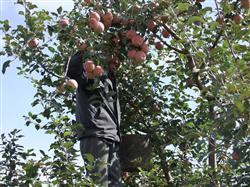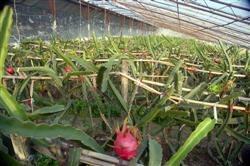A New method of pruning Apple trees in Summer and Autumn

There are many ways to prune apple trees in summer and autumn, but they are often complicated and difficult for fruit growers to master and implement. By using segmented branch turning instead of other traditional complex techniques such as ring peeling, ring cutting, branch pulling and sprouting, we can also obtain the effect of moderate and robust apple trees, reduction of diseases and insect pests and a string of high-quality fruits year after year. The specific methods are as follows: first, the principle of branch rotation destroys the branch tissue structure and reduces the energy supply and transport of the tree by transferring strong or virtual branches, especially the oblique branches on the back, thus inhibiting its vegetative growth. At the same time, the nutrients produced by photosynthesis are also effectively intercepted and forcibly accumulated, which plays a multiple role in inhibiting vegetative growth, promoting reproductive growth and balanced growth. In line with the growth and fruiting habits of fruit trees, the branches are stretched, the branches are strong, ventilated and transparent, the nutrition is balanced, and the fruit produced is large and colorful. Second, the effect of branch rotation can replace the complex summer pruning techniques such as bud carving, coring, hat pruning and so on. Before the middle of June, it also has the function of forming high-quality flower buds and promoting fruit expansion in the same year. Sectional branch transfer at the strong-weak junction of 30 cm to 50 cm at the base of perennial branches can promote branches at the base, form flowers at the back, and reduce diseases and insect pests. Third, the effect of branch transfer has been proved by production practice for many years. It can not only achieve the effect of early fruit, high yield and high quality, but also simplify cultivation and produce high-grade fruit. At the same time, it can also reduce early defoliation. 4. The branches with less perennial fruit, the branches that are not easy to droop after the fruit, and the strong branches or auxiliary shoots of the strong lignified shoots of the current year can all adopt the method of multi-stage branching. 5. Roughly speaking, the whole growing season can be divided into three times, that is, before and after germination, from May to mid-June and from August to mid-September. The experiment shows that as long as it is regulated strictly according to the fertilization standard of organic apple and spraying love and more harvest on the tree, as long as the branch is transferred continuously for 1 ~ 2 years, there is almost no branch transfer after that, which is simple and efficient. 6. the position and angle of the branch are generally turned at the strong and weak intersection of the branch, turning the strong and strong branch 180 degrees. Seventh, the method of branch transfer 1. For branches that turn from the base, turn to whichever side there is room. For erect or side branches that are too thick, live branches can be carried out from the base, then press the outside of the transferred branch upward with the left thumb, and then hold the base tightly with the other four fingers, about 33 cm from the base, with the right thumb down the branch and relative to the fingertip of the left thumb, and the rest fingers clench the waist of the transferred branch, both hands work hard at the same time, turning in the same direction, while pressing down and clockwise. When the pressure angle is 90 °120 degrees and the rotation angle is 180 degrees, the upper branch of Zhiwang back can be turned into a half-lateral drooping shape. To transfer branches from the base, it is necessary to achieve the effect of cracking at the base. In the process of turning, when you hear a crisp clap, and there are 3-5 cm cis-branch cracks at the base, that is to achieve the effect of turning branches. two。 For oblique branches, the branches can be transferred every 15-20 cm from the base to 15-25 cm, turning to semi-lateral or semi-pendulous. 3. For the strong branches before and after the weak branches in the lateral position, the branches can be transferred from the strong-weak junction to the yin-yang position.
- Prev

Introduction of dragon fruit
The dragon fruit, which originated from the tropical rain forest of Central America, is a plant of the genus Opuntia and Ophiopodiaceae. It was introduced into Southeast Asian countries and Taiwan by the French and Dutch. The dragon fruit has a deep historical relationship with religious culture, which can be found near the American Mayans, Inca pyramids and Vietnamese temples in Asia.
- Next

Postharvest management of apple trees
The leaves of apple trees basically finished before late September, and the organic nutrition accumulation of early deciduous fruit trees decreased significantly, which affected the late differentiation of flower buds and the flowering and fruit setting of next year, and had an adverse effect on the overwintering of fruit trees. rot and early defoliation disease will also aggravate. In order to reduce losses, winter and spring should focus on some remedial work.
Related
- Moge, come on! The staff of the peasant association in the producing area of cantaloupe were frightened when the crowd gathered.
- Causes and Solutions of low Fruit setting rate of Apple
- Symptoms and control measures of passion fruit virus disease
- Fruit growing lesson: how do apple orchards keep high yields?
- Can you build orchards in the mountains? What are the pros and cons?
- How to manage the coloring period of Crisson grape?
- This paper introduces the processing technology of two kinds of fig products.
- How much is a month for retired teachers in rural areas by 2020?
- How can strawberry planting increase sugar content? We should pay attention to management in many aspects.
- What are the cultivation techniques on how to improve the yield of golden fruit?

